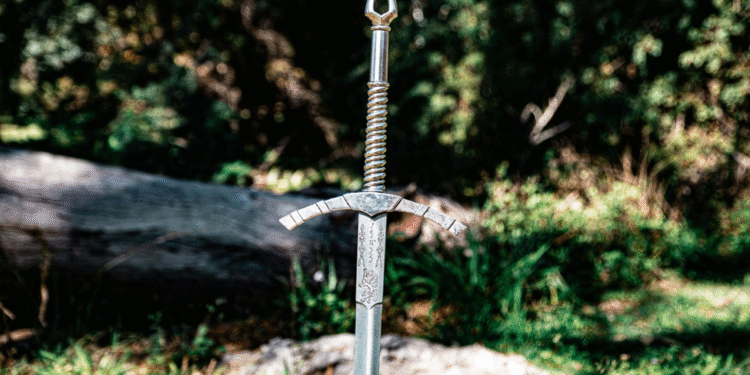The swords of Middle-earth aren’t just weapons—they’re part of the story. From ancient blades reforged for kings to enchanted daggers made by Elves, each one carries history, power, and meaning. Whether you’re a lifelong Tolkien fan, a collector, or preparing for your next cosplay event, understanding these legendary weapons brings the world of The Lord of the Rings to life.
In this guide, we’ll explore the most iconic swords from the saga, who wielded them, and what makes them so special.
Andúril – The Sword Reforged for a King
Few swords are as important as Andúril. Originally known as Narsil, this blade was broken in the battle against Sauron and later reforged for Aragorn as a symbol of his destiny. The name Andúril means “Flame of the West”, and its shining blade marks Aragorn’s return as the rightful heir to the throne of Gondor.
Elegant, powerful, and steeped in legend, Andúril stands as a visual reminder of hope and renewal. It’s no surprise that it’s become one of the most recognisable and revered swords among fans and collectors alike.
Sting – Small but Deadly
Discovered in a troll hoard during The Hobbit, Sting is an Elven blade that’s perfectly suited to a Hobbit’s hand. First carried by Bilbo and later passed to Frodo, it’s famous for glowing blue in the presence of Orcs—a useful feature when wandering into danger.
Though small in size, Sting plays a big role in both Bilbo and Frodo’s stories. Its detailed craftsmanship and magical glow make it a favourite among those looking to add a touch of Elven charm to their cosplay or sword display.
Glamdring – The Sword of Gandalf
When Gandalf acquires Glamdring, he takes up a sword with a history stretching back to the First Age. Once used by the Elven king Turgon, this blade was forged in Gondolin and glows with a cold light when Orcs are near. Nicknamed “Foe-Hammer”, Glamdring is both beautiful and deadly.
With its curved guard and intricate design, it matches Gandalf’s commanding presence. Fans of the wizard often turn to Glamdring as a key piece of their costume or collection.
Orcrist – The Goblin-Cleaver
Also found in the troll cave, Orcrist was claimed by Thorin Oakenshield and carried into battle against goblins and Orcs. It’s sometimes called the “Goblin-cleaver”, and like Sting and Glamdring, it glows blue when danger is close.
With a distinctive curved blade and bold appearance, Orcrist suits Thorin’s fiery leadership style. It’s an ideal choice for those who favour Dwarven design or are looking to recreate Thorin’s regal look from The Hobbit.
Herugrim – Sword of the Horse-lord
Carried by King Théoden of Rohan, Herugrim is more than just a blade—it’s a royal symbol. With a horse-head pommel and a broad, gleaming blade, it reflects the Rohirrim’s strong connection to horses and tradition.
Reclaimed by Gandalf from Gríma Wormtongue, Herugrim is returned to Théoden as he regains control of his kingdom. It’s a powerful moment, made even more striking by the sword’s elegant design.
For collectors who admire the Riders of Rohan or plan to cosplay as Théoden, Herugrim is a must-have.
Hadhafang – The Elven Blade of Arwen
Though not part of Tolkien’s original books, Hadhafang features prominently in the film adaptations. This gracefully curved Elven sword is used by Arwen during her daring ride to protect Frodo from the Nazgûl.
Its name means “throng-cleaver”, and it once belonged to Elrond. With sweeping lines and detailed engravings, Hadhafang embodies Elven elegance. It’s become a favourite for fans of Arwen and Elven warriors alike, whether for display or live-action roleplay.
The Witch-king’s Sword – A Blade of Darkness
Massive and menacing, the Witch-king’s sword suits the leader of the Nazgûl perfectly. This dark, brutal weapon is used during the Battle of Pelennor Fields, where he famously faces off against Éowyn.
Rusted, jagged, and forged with dark sorcery, the sword captures the terrifying aura of the Ringwraiths. Those who prefer the villains of Middle-earth often turn to this blade to complete a haunting, unforgettable look.
Why These Swords Stand Out
Unlike ordinary weapons, swords in Tolkien’s world are characters in their own right. They’re named, passed down, broken, and reforged. Each one is deeply tied to the person who wields it—reflecting their fate, identity, and journey.
That’s why they remain so popular with collectors, fans, and cosplayers. These are not just props; they’re a way to connect with the heart of the story.
When you hold a replica of Andúril or Sting, you’re holding a piece of Middle-earth’s legend.
Choosing the Right Sword for Your Collection or Cosplay
If you’re looking to buy a replica, there are a few things to keep in mind:
- Character fit: Choose a sword that aligns with your favourite hero (or villain). Whether you’re drawn to Aragorn’s nobility or Frodo’s quiet courage, the sword you choose should reflect that.
- Detail and design: Look for high-quality finishes, accurate inscriptions, and materials that match the look from the films.
- Weight and size: Some swords are full-scale and heavier, ideal for display. Others are lightweight replicas better suited to cosplay or conventions.
- Licensed replicas: Officially licensed swords tend to have more authentic designs, matching closely with the film props.
A Lasting Legacy
Tolkien’s world endures not just through words, but through the symbols and relics within it. Swords like Andúril, Sting, and Glamdring carry with them the weight of history, heroism, and magic. For fans of The Lord of the Rings Swords, these blades offer more than decoration—they’re a doorway into one of the richest fantasy worlds ever created.
Whether you’re building a collection or stepping into character, a well-chosen sword brings Middle-earth one step closer.
So next time you ask, “What sword did Aragorn use?” or “What sword glows in the dark?”, you’ll not only know the name — you’ll understand its place in the grand tapestry of one of the greatest fantasy stories ever told.













